Economic Feasibility of Pump Hydro Storage Using Water Wells
VerifiedAdded on 2023/06/13
|32
|5730
|436
Report
AI Summary
This report presents an economic feasibility study on utilizing existing water wells in agricultural lands for pump hydro storage, aiming to address the intermittent nature of renewable energy sources. The study involves a detailed design and evaluation of the proposed system, considering various aspects and conditions. It compares the costs (initial, operating, labor, maintenance, and replacement) of the proposed system with an existing solar battery system, using appropriate assumptions and methodologies. The report discusses the results, includes graphical representations, and concludes on the viability of the proposed pump hydro storage system as a cost-effective and reliable energy storage solution, eliminating the need for batteries and mitigating the challenges associated with renewable energy intermittency. Desklib provides access to similar documents and study tools for students.
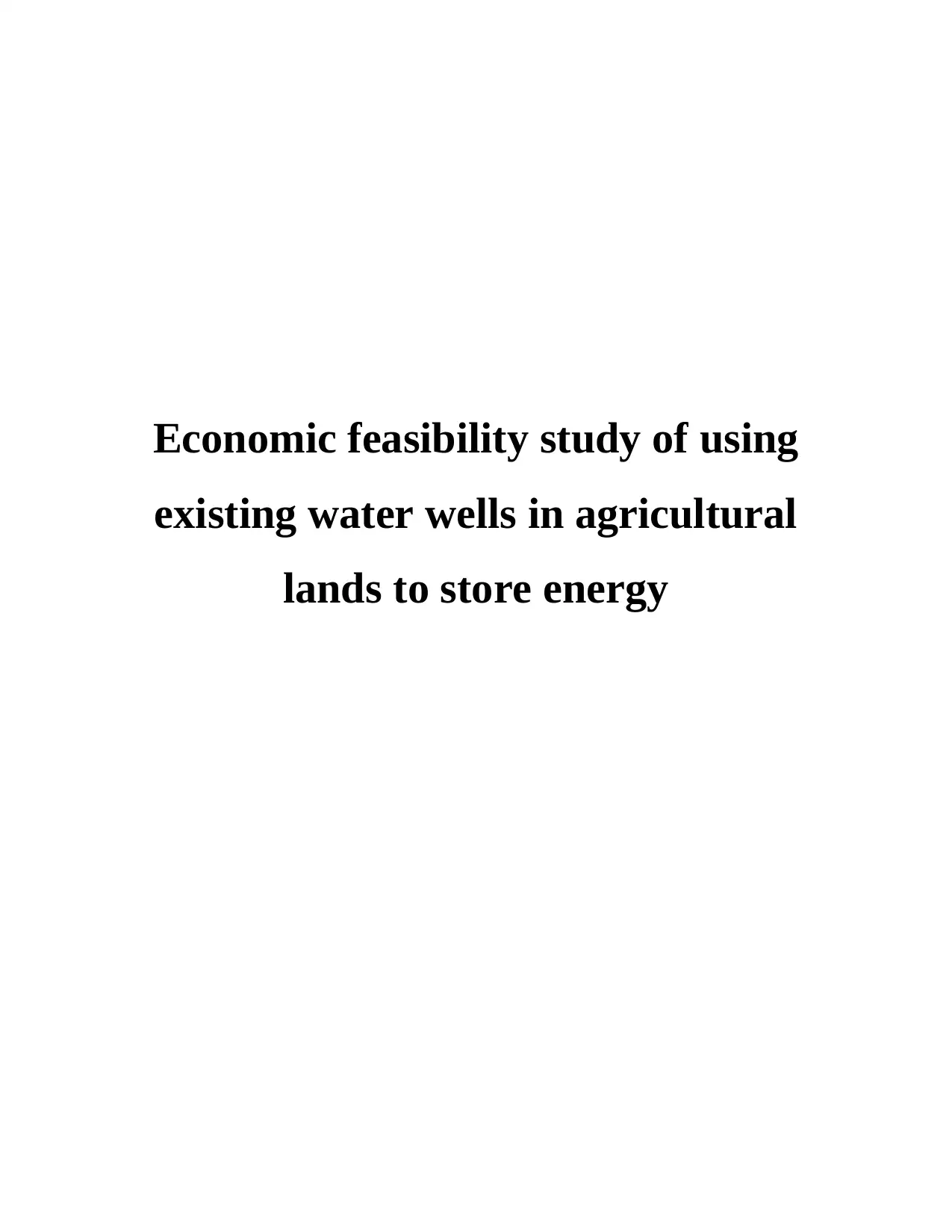
Economic feasibility study of using
existing water wells in agricultural
lands to store energy
existing water wells in agricultural
lands to store energy
Paraphrase This Document
Need a fresh take? Get an instant paraphrase of this document with our AI Paraphraser
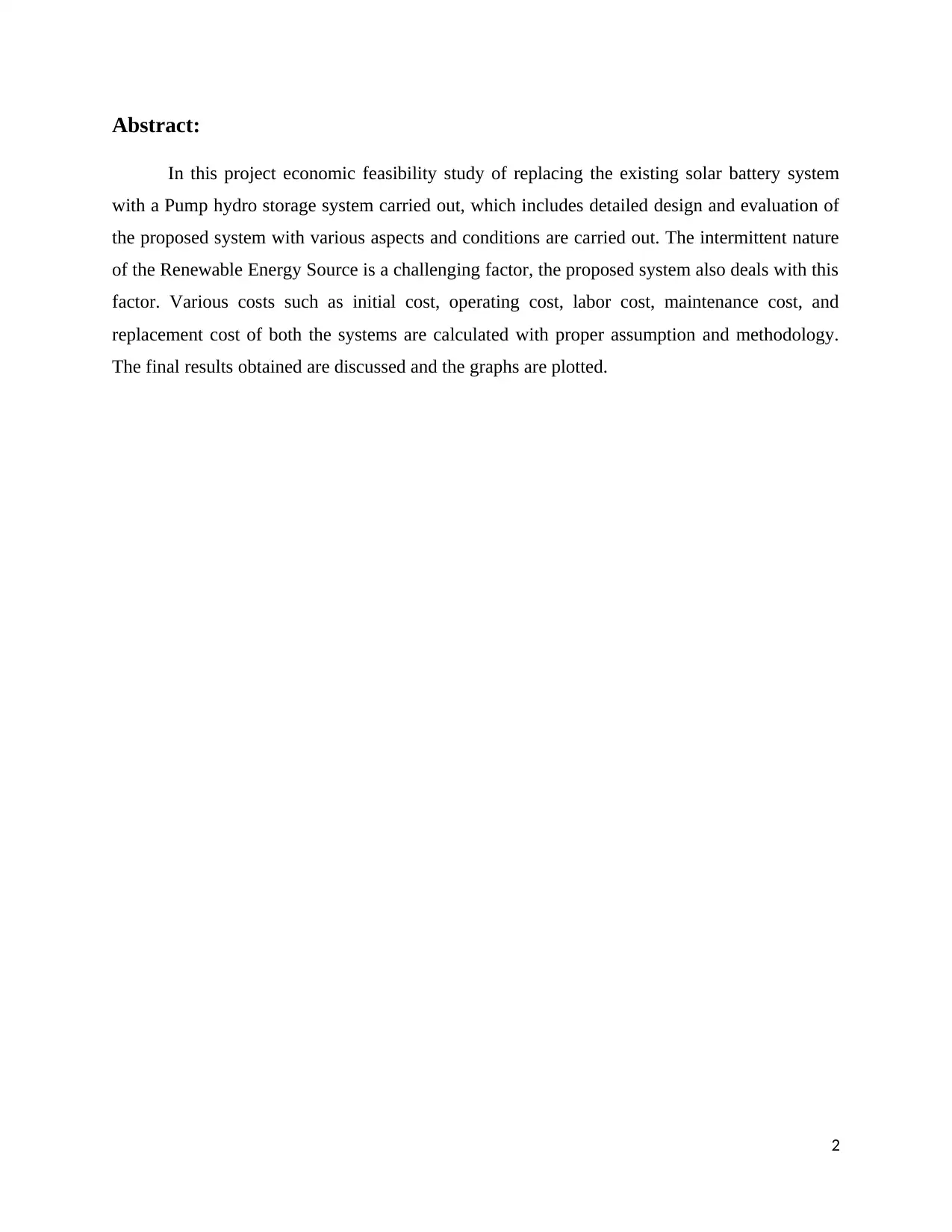
Abstract:
In this project economic feasibility study of replacing the existing solar battery system
with a Pump hydro storage system carried out, which includes detailed design and evaluation of
the proposed system with various aspects and conditions are carried out. The intermittent nature
of the Renewable Energy Source is a challenging factor, the proposed system also deals with this
factor. Various costs such as initial cost, operating cost, labor cost, maintenance cost, and
replacement cost of both the systems are calculated with proper assumption and methodology.
The final results obtained are discussed and the graphs are plotted.
2
In this project economic feasibility study of replacing the existing solar battery system
with a Pump hydro storage system carried out, which includes detailed design and evaluation of
the proposed system with various aspects and conditions are carried out. The intermittent nature
of the Renewable Energy Source is a challenging factor, the proposed system also deals with this
factor. Various costs such as initial cost, operating cost, labor cost, maintenance cost, and
replacement cost of both the systems are calculated with proper assumption and methodology.
The final results obtained are discussed and the graphs are plotted.
2
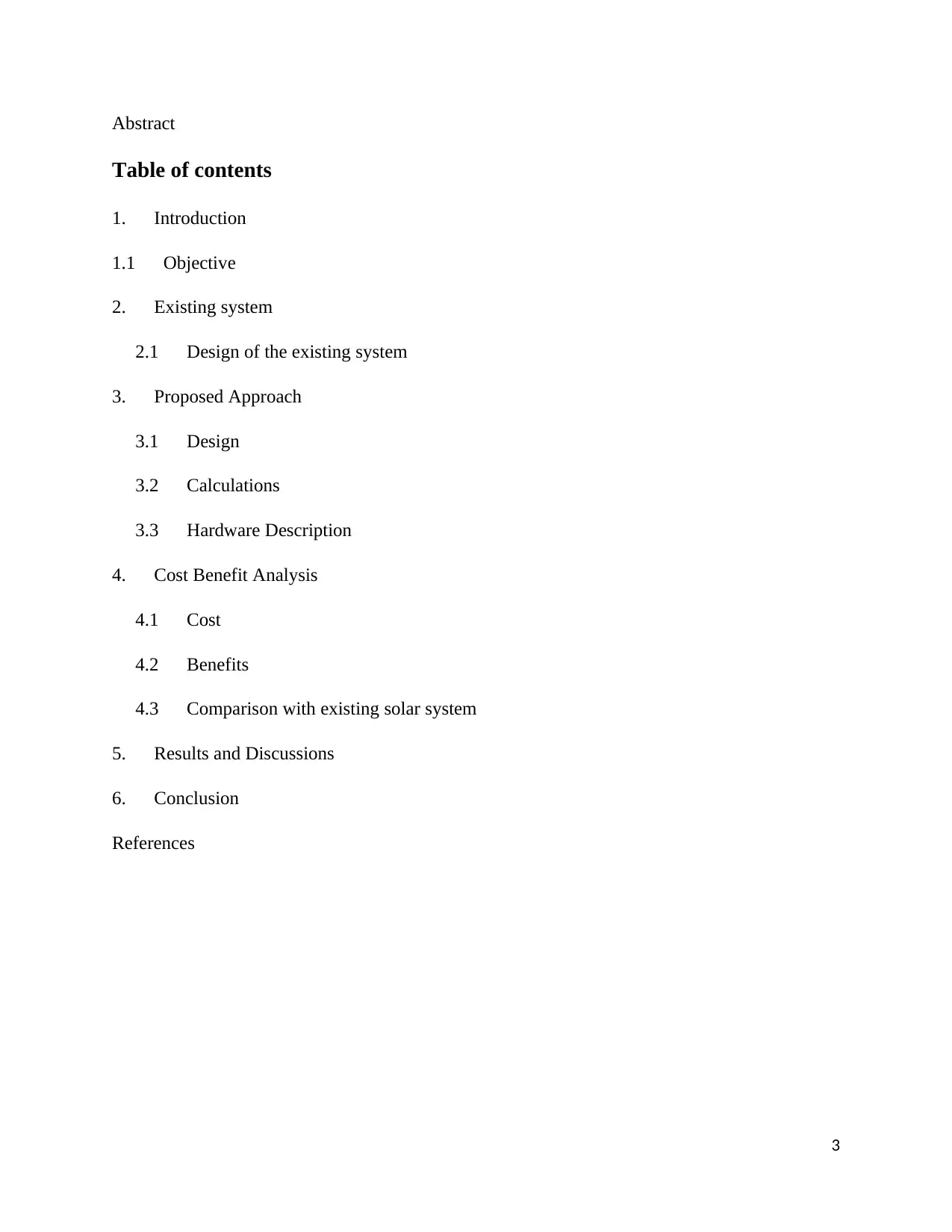
Abstract
Table of contents
1. Introduction
1.1 Objective
2. Existing system
2.1 Design of the existing system
3. Proposed Approach
3.1 Design
3.2 Calculations
3.3 Hardware Description
4. Cost Benefit Analysis
4.1 Cost
4.2 Benefits
4.3 Comparison with existing solar system
5. Results and Discussions
6. Conclusion
References
3
Table of contents
1. Introduction
1.1 Objective
2. Existing system
2.1 Design of the existing system
3. Proposed Approach
3.1 Design
3.2 Calculations
3.3 Hardware Description
4. Cost Benefit Analysis
4.1 Cost
4.2 Benefits
4.3 Comparison with existing solar system
5. Results and Discussions
6. Conclusion
References
3
⊘ This is a preview!⊘
Do you want full access?
Subscribe today to unlock all pages.

Trusted by 1+ million students worldwide
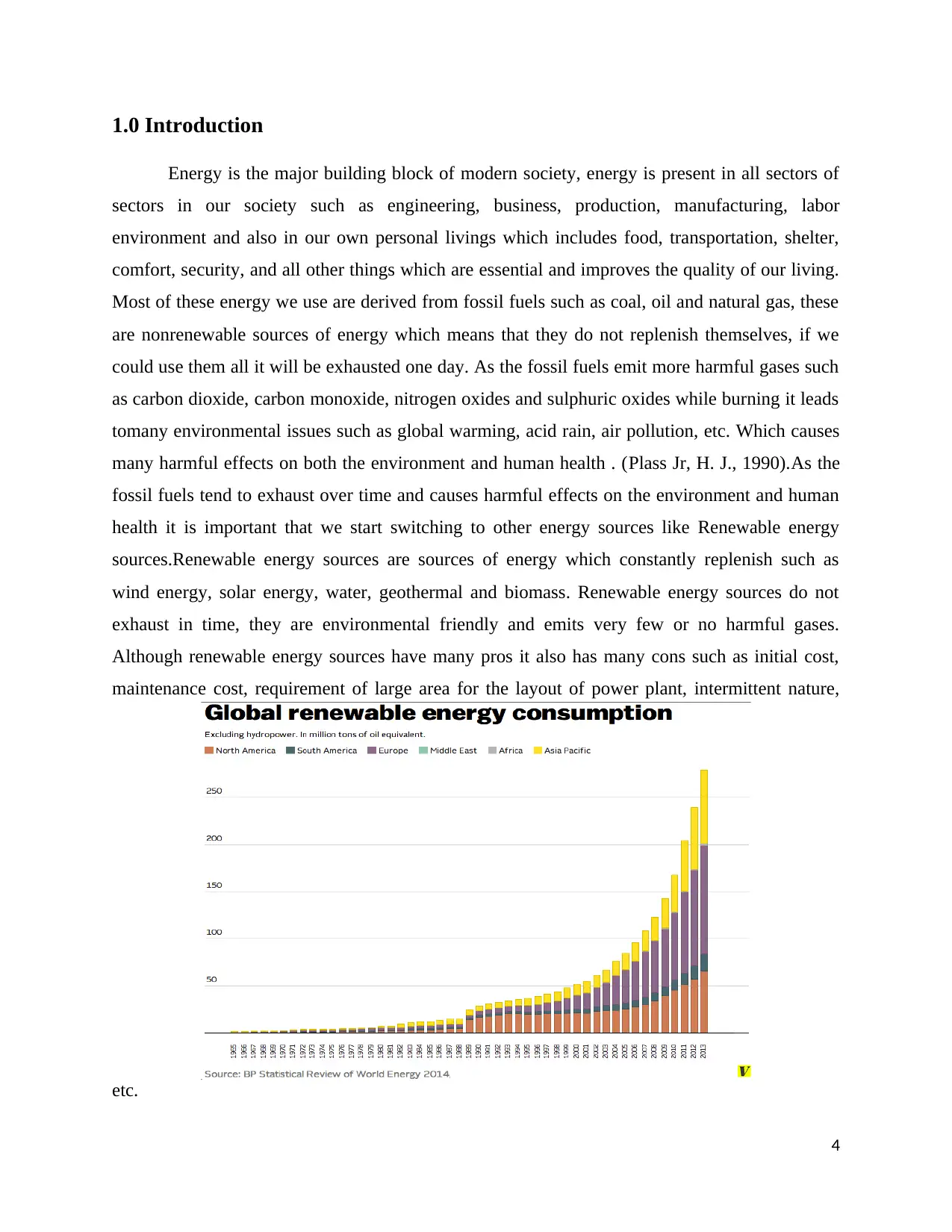
1.0 Introduction
Energy is the major building block of modern society, energy is present in all sectors of
sectors in our society such as engineering, business, production, manufacturing, labor
environment and also in our own personal livings which includes food, transportation, shelter,
comfort, security, and all other things which are essential and improves the quality of our living.
Most of these energy we use are derived from fossil fuels such as coal, oil and natural gas, these
are nonrenewable sources of energy which means that they do not replenish themselves, if we
could use them all it will be exhausted one day. As the fossil fuels emit more harmful gases such
as carbon dioxide, carbon monoxide, nitrogen oxides and sulphuric oxides while burning it leads
tomany environmental issues such as global warming, acid rain, air pollution, etc. Which causes
many harmful effects on both the environment and human health . (Plass Jr, H. J., 1990).As the
fossil fuels tend to exhaust over time and causes harmful effects on the environment and human
health it is important that we start switching to other energy sources like Renewable energy
sources.Renewable energy sources are sources of energy which constantly replenish such as
wind energy, solar energy, water, geothermal and biomass. Renewable energy sources do not
exhaust in time, they are environmental friendly and emits very few or no harmful gases.
Although renewable energy sources have many pros it also has many cons such as initial cost,
maintenance cost, requirement of large area for the layout of power plant, intermittent nature,
etc.
4
Energy is the major building block of modern society, energy is present in all sectors of
sectors in our society such as engineering, business, production, manufacturing, labor
environment and also in our own personal livings which includes food, transportation, shelter,
comfort, security, and all other things which are essential and improves the quality of our living.
Most of these energy we use are derived from fossil fuels such as coal, oil and natural gas, these
are nonrenewable sources of energy which means that they do not replenish themselves, if we
could use them all it will be exhausted one day. As the fossil fuels emit more harmful gases such
as carbon dioxide, carbon monoxide, nitrogen oxides and sulphuric oxides while burning it leads
tomany environmental issues such as global warming, acid rain, air pollution, etc. Which causes
many harmful effects on both the environment and human health . (Plass Jr, H. J., 1990).As the
fossil fuels tend to exhaust over time and causes harmful effects on the environment and human
health it is important that we start switching to other energy sources like Renewable energy
sources.Renewable energy sources are sources of energy which constantly replenish such as
wind energy, solar energy, water, geothermal and biomass. Renewable energy sources do not
exhaust in time, they are environmental friendly and emits very few or no harmful gases.
Although renewable energy sources have many pros it also has many cons such as initial cost,
maintenance cost, requirement of large area for the layout of power plant, intermittent nature,
etc.
4
Paraphrase This Document
Need a fresh take? Get an instant paraphrase of this document with our AI Paraphraser
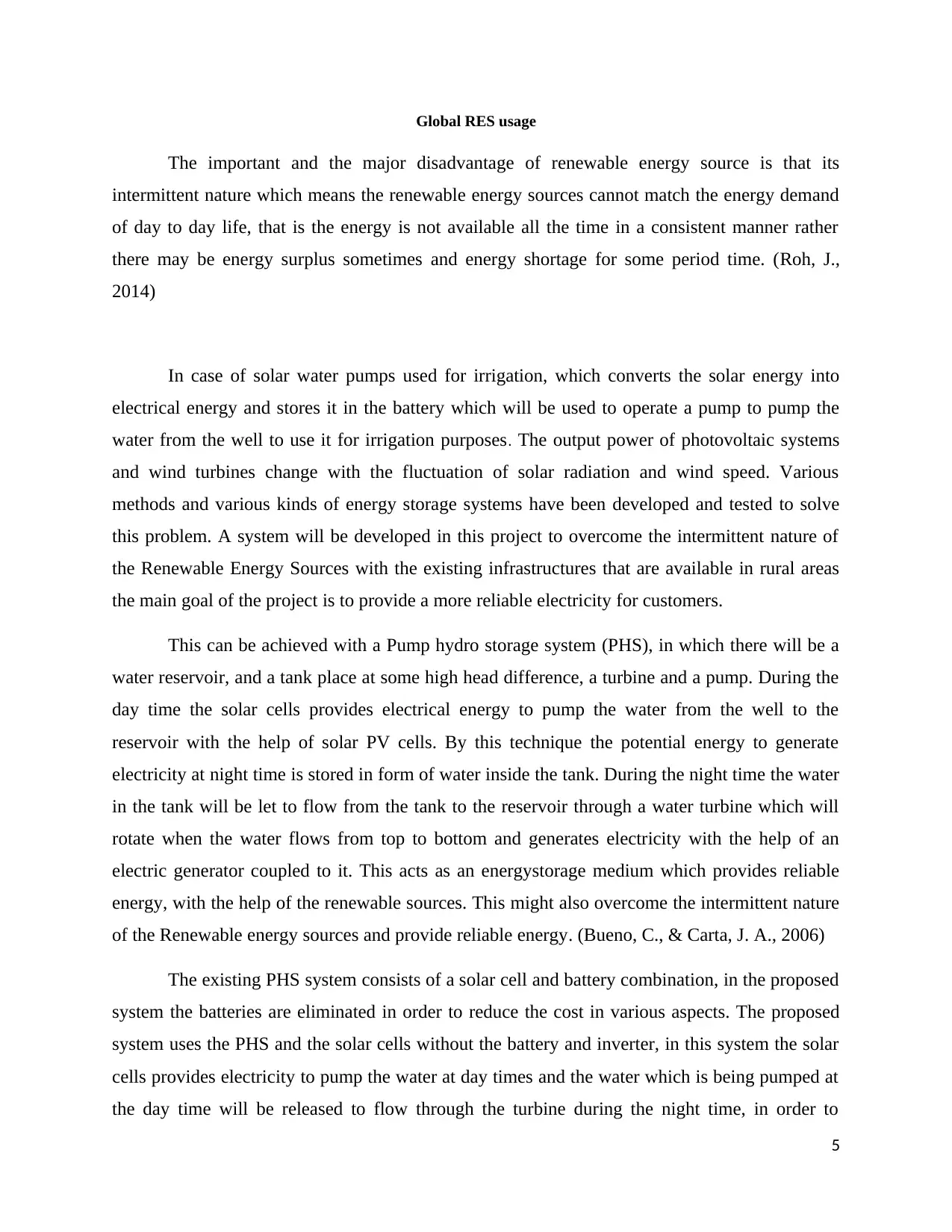
Global RES usage
The important and the major disadvantage of renewable energy source is that its
intermittent nature which means the renewable energy sources cannot match the energy demand
of day to day life, that is the energy is not available all the time in a consistent manner rather
there may be energy surplus sometimes and energy shortage for some period time. (Roh, J.,
2014)
In case of solar water pumps used for irrigation, which converts the solar energy into
electrical energy and stores it in the battery which will be used to operate a pump to pump the
water from the well to use it for irrigation purposes. The output power of photovoltaic systems
and wind turbines change with the fluctuation of solar radiation and wind speed. Various
methods and various kinds of energy storage systems have been developed and tested to solve
this problem. A system will be developed in this project to overcome the intermittent nature of
the Renewable Energy Sources with the existing infrastructures that are available in rural areas
the main goal of the project is to provide a more reliable electricity for customers.
This can be achieved with a Pump hydro storage system (PHS), in which there will be a
water reservoir, and a tank place at some high head difference, a turbine and a pump. During the
day time the solar cells provides electrical energy to pump the water from the well to the
reservoir with the help of solar PV cells. By this technique the potential energy to generate
electricity at night time is stored in form of water inside the tank. During the night time the water
in the tank will be let to flow from the tank to the reservoir through a water turbine which will
rotate when the water flows from top to bottom and generates electricity with the help of an
electric generator coupled to it. This acts as an energystorage medium which provides reliable
energy, with the help of the renewable sources. This might also overcome the intermittent nature
of the Renewable energy sources and provide reliable energy. (Bueno, C., & Carta, J. A., 2006)
The existing PHS system consists of a solar cell and battery combination, in the proposed
system the batteries are eliminated in order to reduce the cost in various aspects. The proposed
system uses the PHS and the solar cells without the battery and inverter, in this system the solar
cells provides electricity to pump the water at day times and the water which is being pumped at
the day time will be released to flow through the turbine during the night time, in order to
5
The important and the major disadvantage of renewable energy source is that its
intermittent nature which means the renewable energy sources cannot match the energy demand
of day to day life, that is the energy is not available all the time in a consistent manner rather
there may be energy surplus sometimes and energy shortage for some period time. (Roh, J.,
2014)
In case of solar water pumps used for irrigation, which converts the solar energy into
electrical energy and stores it in the battery which will be used to operate a pump to pump the
water from the well to use it for irrigation purposes. The output power of photovoltaic systems
and wind turbines change with the fluctuation of solar radiation and wind speed. Various
methods and various kinds of energy storage systems have been developed and tested to solve
this problem. A system will be developed in this project to overcome the intermittent nature of
the Renewable Energy Sources with the existing infrastructures that are available in rural areas
the main goal of the project is to provide a more reliable electricity for customers.
This can be achieved with a Pump hydro storage system (PHS), in which there will be a
water reservoir, and a tank place at some high head difference, a turbine and a pump. During the
day time the solar cells provides electrical energy to pump the water from the well to the
reservoir with the help of solar PV cells. By this technique the potential energy to generate
electricity at night time is stored in form of water inside the tank. During the night time the water
in the tank will be let to flow from the tank to the reservoir through a water turbine which will
rotate when the water flows from top to bottom and generates electricity with the help of an
electric generator coupled to it. This acts as an energystorage medium which provides reliable
energy, with the help of the renewable sources. This might also overcome the intermittent nature
of the Renewable energy sources and provide reliable energy. (Bueno, C., & Carta, J. A., 2006)
The existing PHS system consists of a solar cell and battery combination, in the proposed
system the batteries are eliminated in order to reduce the cost in various aspects. The proposed
system uses the PHS and the solar cells without the battery and inverter, in this system the solar
cells provides electricity to pump the water at day times and the water which is being pumped at
the day time will be released to flow through the turbine during the night time, in order to
5
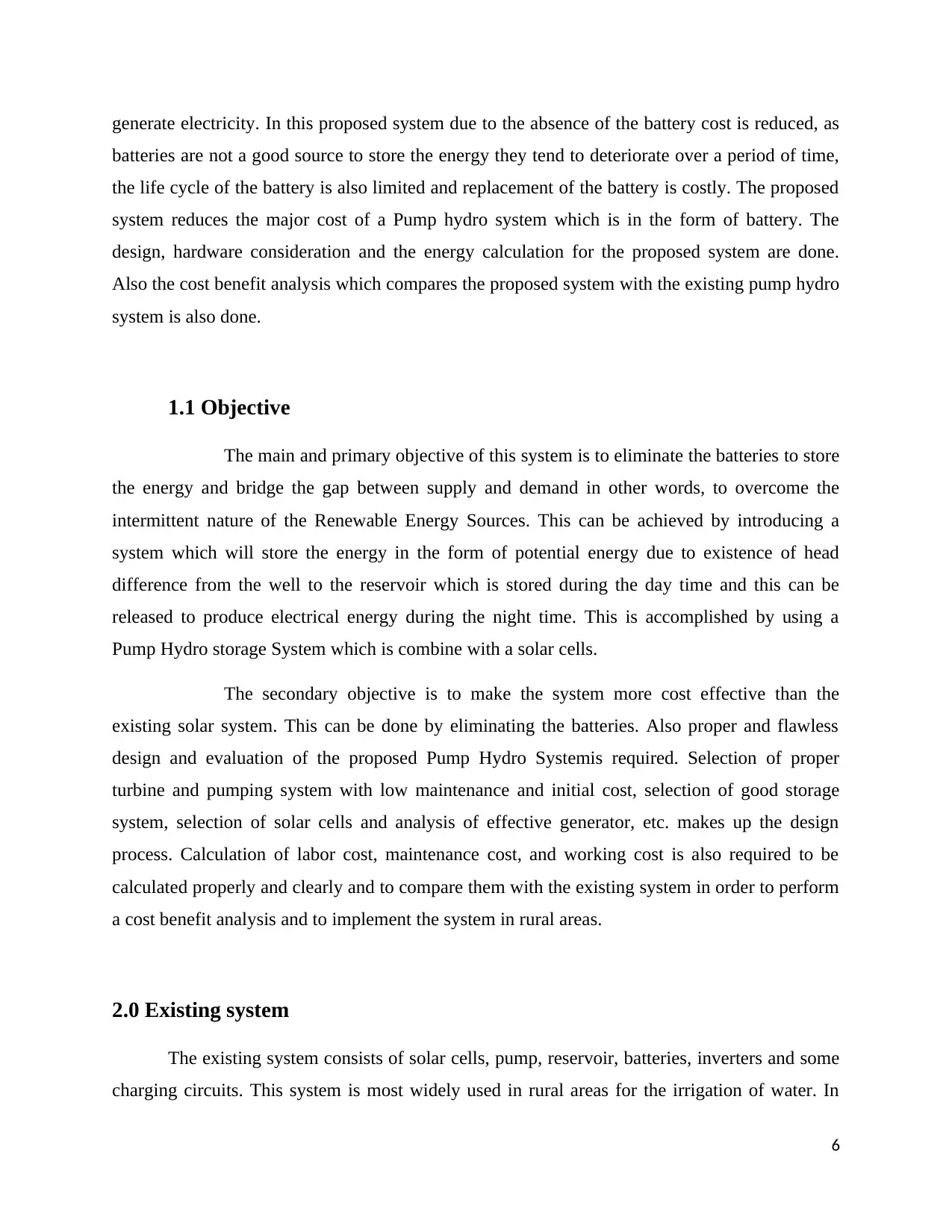
generate electricity. In this proposed system due to the absence of the battery cost is reduced, as
batteries are not a good source to store the energy they tend to deteriorate over a period of time,
the life cycle of the battery is also limited and replacement of the battery is costly. The proposed
system reduces the major cost of a Pump hydro system which is in the form of battery. The
design, hardware consideration and the energy calculation for the proposed system are done.
Also the cost benefit analysis which compares the proposed system with the existing pump hydro
system is also done.
1.1 Objective
The main and primary objective of this system is to eliminate the batteries to store
the energy and bridge the gap between supply and demand in other words, to overcome the
intermittent nature of the Renewable Energy Sources. This can be achieved by introducing a
system which will store the energy in the form of potential energy due to existence of head
difference from the well to the reservoir which is stored during the day time and this can be
released to produce electrical energy during the night time. This is accomplished by using a
Pump Hydro storage System which is combine with a solar cells.
The secondary objective is to make the system more cost effective than the
existing solar system. This can be done by eliminating the batteries. Also proper and flawless
design and evaluation of the proposed Pump Hydro Systemis required. Selection of proper
turbine and pumping system with low maintenance and initial cost, selection of good storage
system, selection of solar cells and analysis of effective generator, etc. makes up the design
process. Calculation of labor cost, maintenance cost, and working cost is also required to be
calculated properly and clearly and to compare them with the existing system in order to perform
a cost benefit analysis and to implement the system in rural areas.
2.0 Existing system
The existing system consists of solar cells, pump, reservoir, batteries, inverters and some
charging circuits. This system is most widely used in rural areas for the irrigation of water. In
6
batteries are not a good source to store the energy they tend to deteriorate over a period of time,
the life cycle of the battery is also limited and replacement of the battery is costly. The proposed
system reduces the major cost of a Pump hydro system which is in the form of battery. The
design, hardware consideration and the energy calculation for the proposed system are done.
Also the cost benefit analysis which compares the proposed system with the existing pump hydro
system is also done.
1.1 Objective
The main and primary objective of this system is to eliminate the batteries to store
the energy and bridge the gap between supply and demand in other words, to overcome the
intermittent nature of the Renewable Energy Sources. This can be achieved by introducing a
system which will store the energy in the form of potential energy due to existence of head
difference from the well to the reservoir which is stored during the day time and this can be
released to produce electrical energy during the night time. This is accomplished by using a
Pump Hydro storage System which is combine with a solar cells.
The secondary objective is to make the system more cost effective than the
existing solar system. This can be done by eliminating the batteries. Also proper and flawless
design and evaluation of the proposed Pump Hydro Systemis required. Selection of proper
turbine and pumping system with low maintenance and initial cost, selection of good storage
system, selection of solar cells and analysis of effective generator, etc. makes up the design
process. Calculation of labor cost, maintenance cost, and working cost is also required to be
calculated properly and clearly and to compare them with the existing system in order to perform
a cost benefit analysis and to implement the system in rural areas.
2.0 Existing system
The existing system consists of solar cells, pump, reservoir, batteries, inverters and some
charging circuits. This system is most widely used in rural areas for the irrigation of water. In
6
⊘ This is a preview!⊘
Do you want full access?
Subscribe today to unlock all pages.

Trusted by 1+ million students worldwide
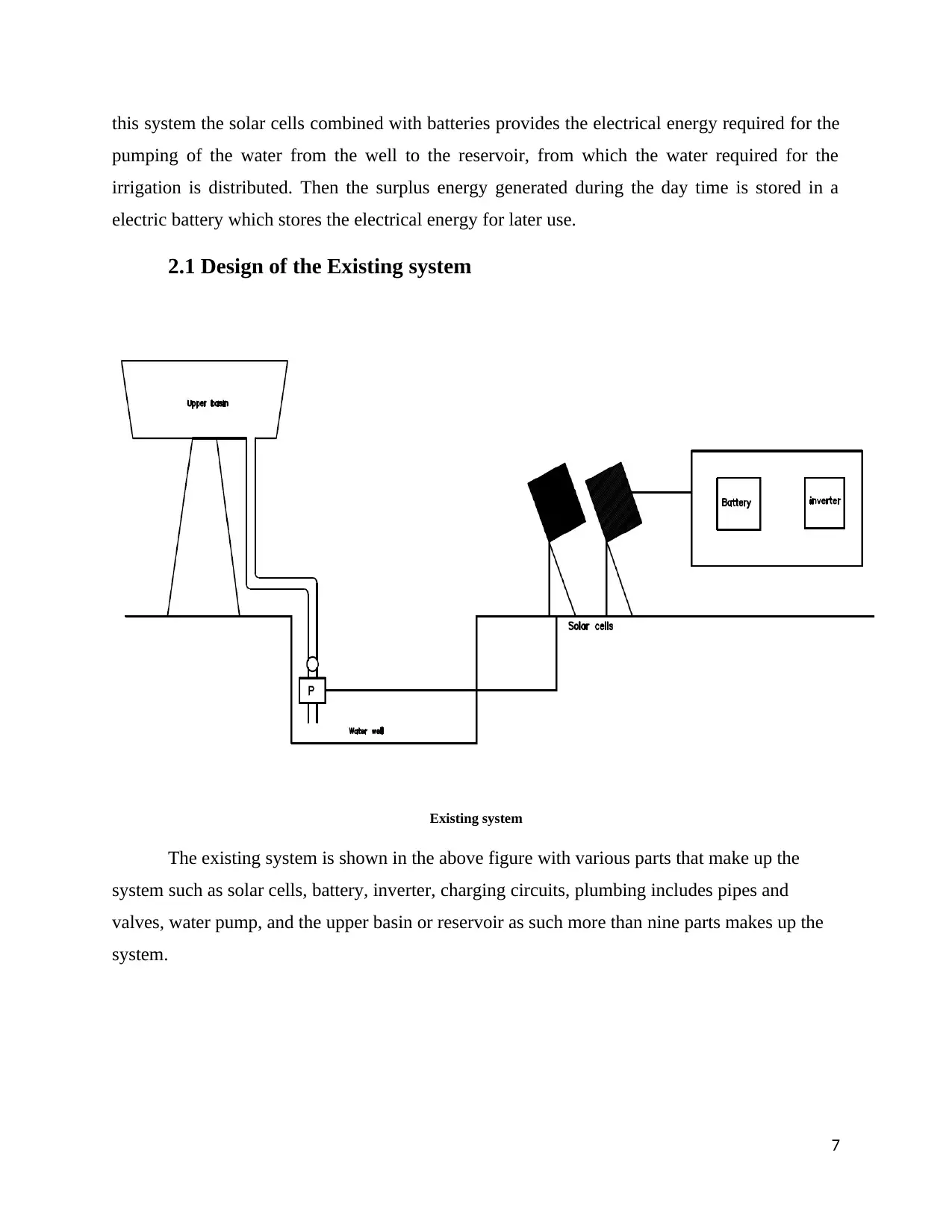
this system the solar cells combined with batteries provides the electrical energy required for the
pumping of the water from the well to the reservoir, from which the water required for the
irrigation is distributed. Then the surplus energy generated during the day time is stored in a
electric battery which stores the electrical energy for later use.
2.1 Design of the Existing system
Existing system
The existing system is shown in the above figure with various parts that make up the
system such as solar cells, battery, inverter, charging circuits, plumbing includes pipes and
valves, water pump, and the upper basin or reservoir as such more than nine parts makes up the
system.
7
pumping of the water from the well to the reservoir, from which the water required for the
irrigation is distributed. Then the surplus energy generated during the day time is stored in a
electric battery which stores the electrical energy for later use.
2.1 Design of the Existing system
Existing system
The existing system is shown in the above figure with various parts that make up the
system such as solar cells, battery, inverter, charging circuits, plumbing includes pipes and
valves, water pump, and the upper basin or reservoir as such more than nine parts makes up the
system.
7
Paraphrase This Document
Need a fresh take? Get an instant paraphrase of this document with our AI Paraphraser
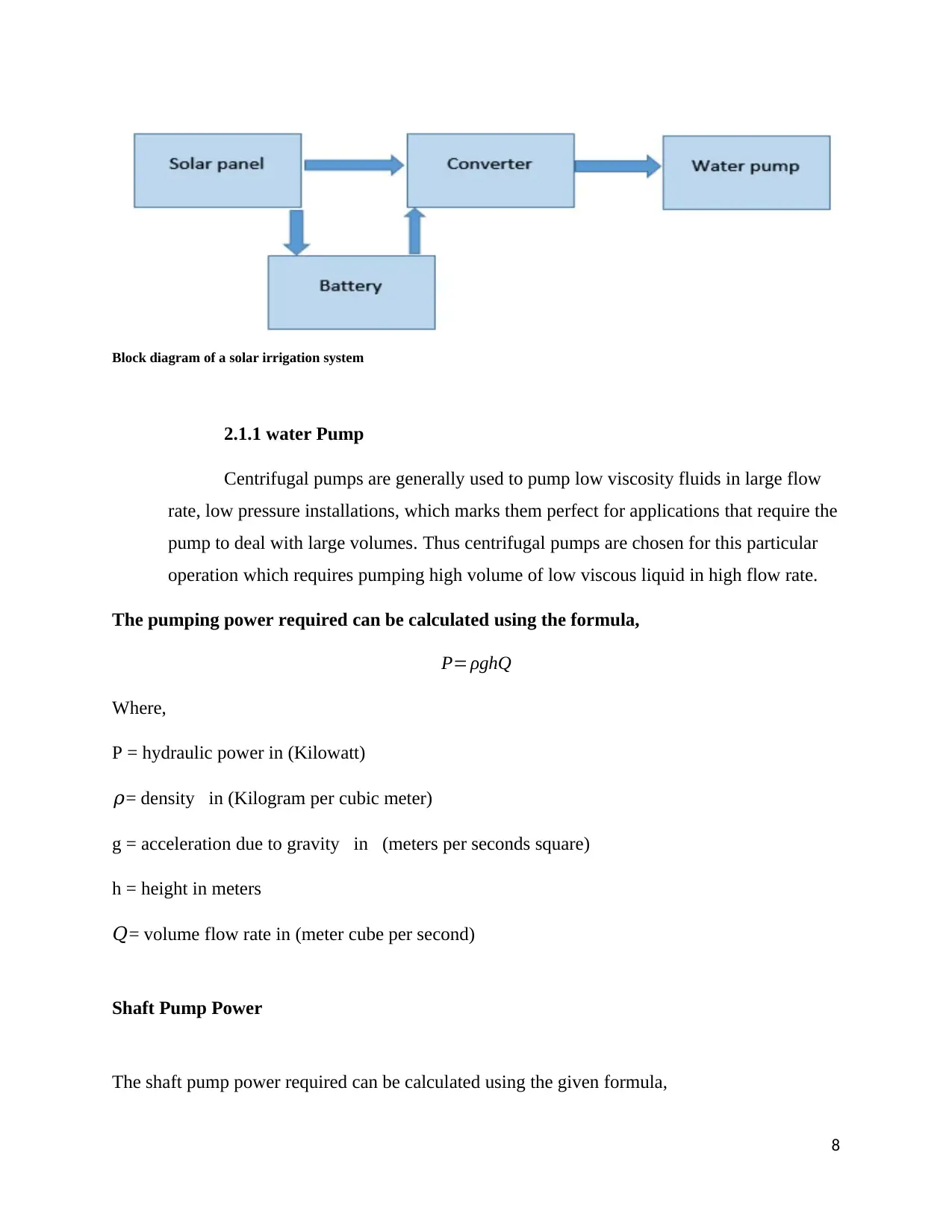
Block diagram of a solar irrigation system
2.1.1 water Pump
Centrifugal pumps are generally used to pump low viscosity fluids in large flow
rate, low pressure installations, which marks them perfect for applications that require the
pump to deal with large volumes. Thus centrifugal pumps are chosen for this particular
operation which requires pumping high volume of low viscous liquid in high flow rate.
The pumping power required can be calculated using the formula,
P= ρghQ
Where,
P = hydraulic power in (Kilowatt)
𝜌= density in (Kilogram per cubic meter)
g = acceleration due to gravity in (meters per seconds square)
h = height in meters
𝑄= volume flow rate in (meter cube per second)
Shaft Pump Power
The shaft pump power required can be calculated using the given formula,
8
2.1.1 water Pump
Centrifugal pumps are generally used to pump low viscosity fluids in large flow
rate, low pressure installations, which marks them perfect for applications that require the
pump to deal with large volumes. Thus centrifugal pumps are chosen for this particular
operation which requires pumping high volume of low viscous liquid in high flow rate.
The pumping power required can be calculated using the formula,
P= ρghQ
Where,
P = hydraulic power in (Kilowatt)
𝜌= density in (Kilogram per cubic meter)
g = acceleration due to gravity in (meters per seconds square)
h = height in meters
𝑄= volume flow rate in (meter cube per second)
Shaft Pump Power
The shaft pump power required can be calculated using the given formula,
8
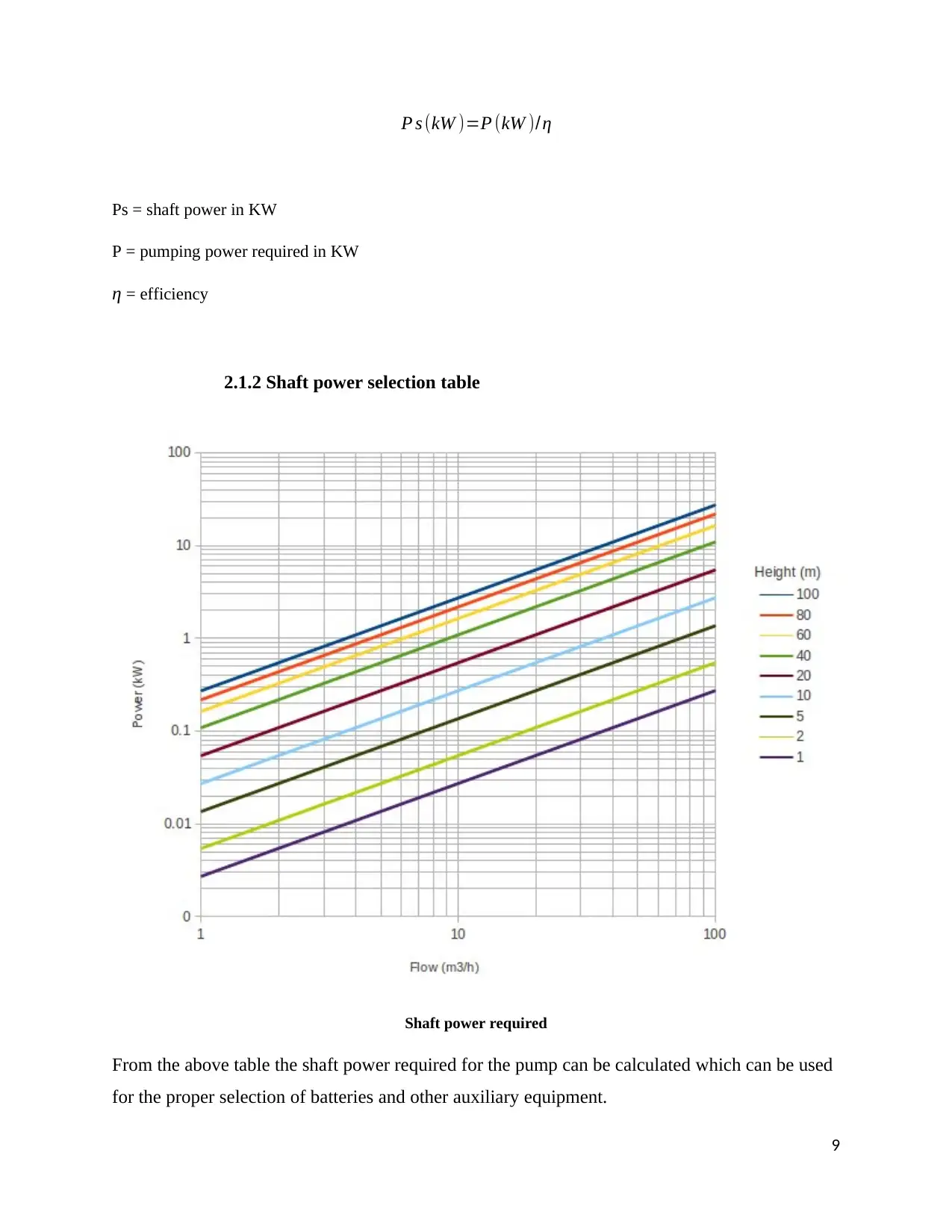
P s (kW )=P (kW )/η
Ps = shaft power in KW
P = pumping power required in KW
η = efficiency
2.1.2 Shaft power selection table
Shaft power required
From the above table the shaft power required for the pump can be calculated which can be used
for the proper selection of batteries and other auxiliary equipment.
9
Ps = shaft power in KW
P = pumping power required in KW
η = efficiency
2.1.2 Shaft power selection table
Shaft power required
From the above table the shaft power required for the pump can be calculated which can be used
for the proper selection of batteries and other auxiliary equipment.
9
⊘ This is a preview!⊘
Do you want full access?
Subscribe today to unlock all pages.

Trusted by 1+ million students worldwide
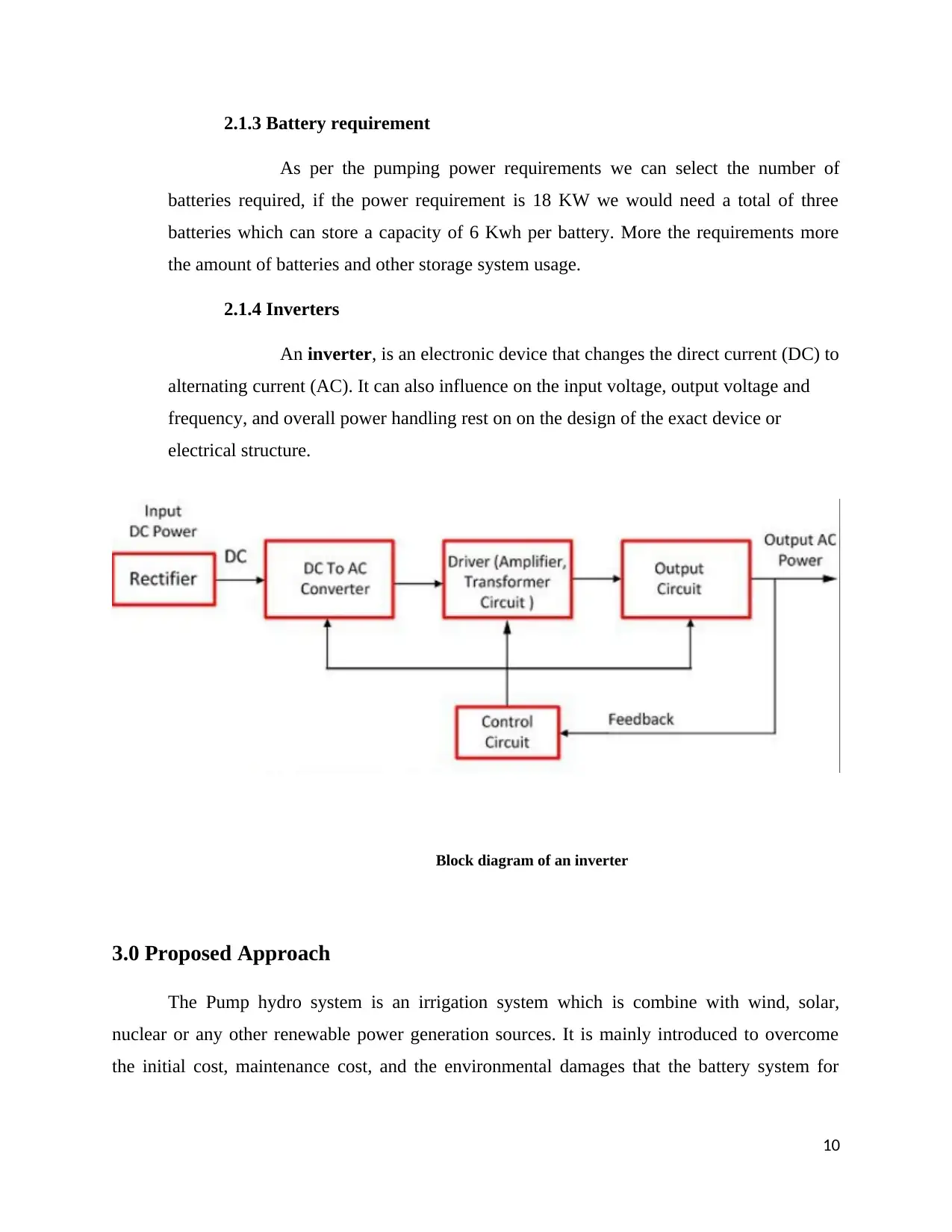
2.1.3 Battery requirement
As per the pumping power requirements we can select the number of
batteries required, if the power requirement is 18 KW we would need a total of three
batteries which can store a capacity of 6 Kwh per battery. More the requirements more
the amount of batteries and other storage system usage.
2.1.4 Inverters
An inverter, is an electronic device that changes the direct current (DC) to
alternating current (AC). It can also influence on the input voltage, output voltage and
frequency, and overall power handling rest on on the design of the exact device or
electrical structure.
Block diagram of an inverter
3.0 Proposed Approach
The Pump hydro system is an irrigation system which is combine with wind, solar,
nuclear or any other renewable power generation sources. It is mainly introduced to overcome
the initial cost, maintenance cost, and the environmental damages that the battery system for
10
As per the pumping power requirements we can select the number of
batteries required, if the power requirement is 18 KW we would need a total of three
batteries which can store a capacity of 6 Kwh per battery. More the requirements more
the amount of batteries and other storage system usage.
2.1.4 Inverters
An inverter, is an electronic device that changes the direct current (DC) to
alternating current (AC). It can also influence on the input voltage, output voltage and
frequency, and overall power handling rest on on the design of the exact device or
electrical structure.
Block diagram of an inverter
3.0 Proposed Approach
The Pump hydro system is an irrigation system which is combine with wind, solar,
nuclear or any other renewable power generation sources. It is mainly introduced to overcome
the initial cost, maintenance cost, and the environmental damages that the battery system for
10
Paraphrase This Document
Need a fresh take? Get an instant paraphrase of this document with our AI Paraphraser
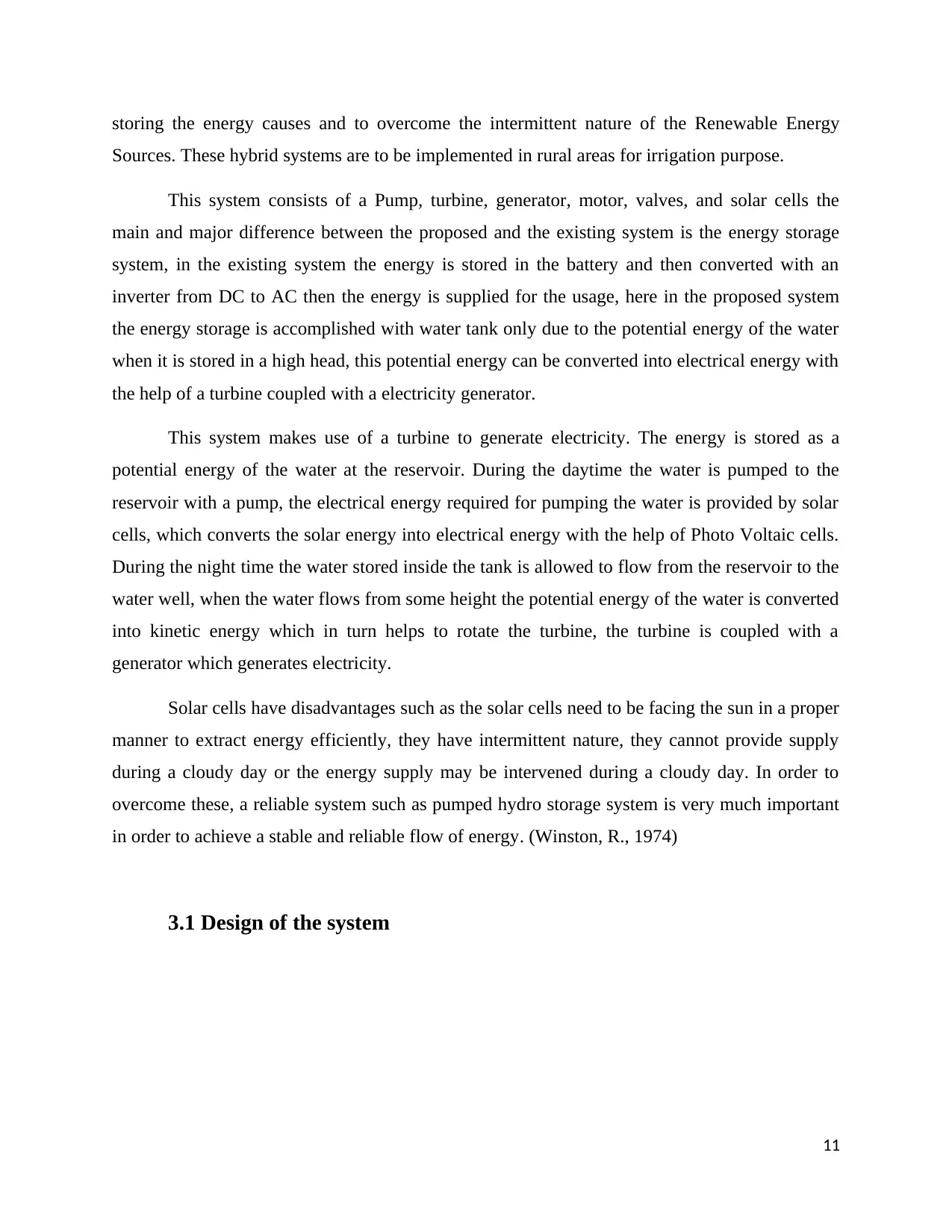
storing the energy causes and to overcome the intermittent nature of the Renewable Energy
Sources. These hybrid systems are to be implemented in rural areas for irrigation purpose.
This system consists of a Pump, turbine, generator, motor, valves, and solar cells the
main and major difference between the proposed and the existing system is the energy storage
system, in the existing system the energy is stored in the battery and then converted with an
inverter from DC to AC then the energy is supplied for the usage, here in the proposed system
the energy storage is accomplished with water tank only due to the potential energy of the water
when it is stored in a high head, this potential energy can be converted into electrical energy with
the help of a turbine coupled with a electricity generator.
This system makes use of a turbine to generate electricity. The energy is stored as a
potential energy of the water at the reservoir. During the daytime the water is pumped to the
reservoir with a pump, the electrical energy required for pumping the water is provided by solar
cells, which converts the solar energy into electrical energy with the help of Photo Voltaic cells.
During the night time the water stored inside the tank is allowed to flow from the reservoir to the
water well, when the water flows from some height the potential energy of the water is converted
into kinetic energy which in turn helps to rotate the turbine, the turbine is coupled with a
generator which generates electricity.
Solar cells have disadvantages such as the solar cells need to be facing the sun in a proper
manner to extract energy efficiently, they have intermittent nature, they cannot provide supply
during a cloudy day or the energy supply may be intervened during a cloudy day. In order to
overcome these, a reliable system such as pumped hydro storage system is very much important
in order to achieve a stable and reliable flow of energy. (Winston, R., 1974)
3.1 Design of the system
11
Sources. These hybrid systems are to be implemented in rural areas for irrigation purpose.
This system consists of a Pump, turbine, generator, motor, valves, and solar cells the
main and major difference between the proposed and the existing system is the energy storage
system, in the existing system the energy is stored in the battery and then converted with an
inverter from DC to AC then the energy is supplied for the usage, here in the proposed system
the energy storage is accomplished with water tank only due to the potential energy of the water
when it is stored in a high head, this potential energy can be converted into electrical energy with
the help of a turbine coupled with a electricity generator.
This system makes use of a turbine to generate electricity. The energy is stored as a
potential energy of the water at the reservoir. During the daytime the water is pumped to the
reservoir with a pump, the electrical energy required for pumping the water is provided by solar
cells, which converts the solar energy into electrical energy with the help of Photo Voltaic cells.
During the night time the water stored inside the tank is allowed to flow from the reservoir to the
water well, when the water flows from some height the potential energy of the water is converted
into kinetic energy which in turn helps to rotate the turbine, the turbine is coupled with a
generator which generates electricity.
Solar cells have disadvantages such as the solar cells need to be facing the sun in a proper
manner to extract energy efficiently, they have intermittent nature, they cannot provide supply
during a cloudy day or the energy supply may be intervened during a cloudy day. In order to
overcome these, a reliable system such as pumped hydro storage system is very much important
in order to achieve a stable and reliable flow of energy. (Winston, R., 1974)
3.1 Design of the system
11
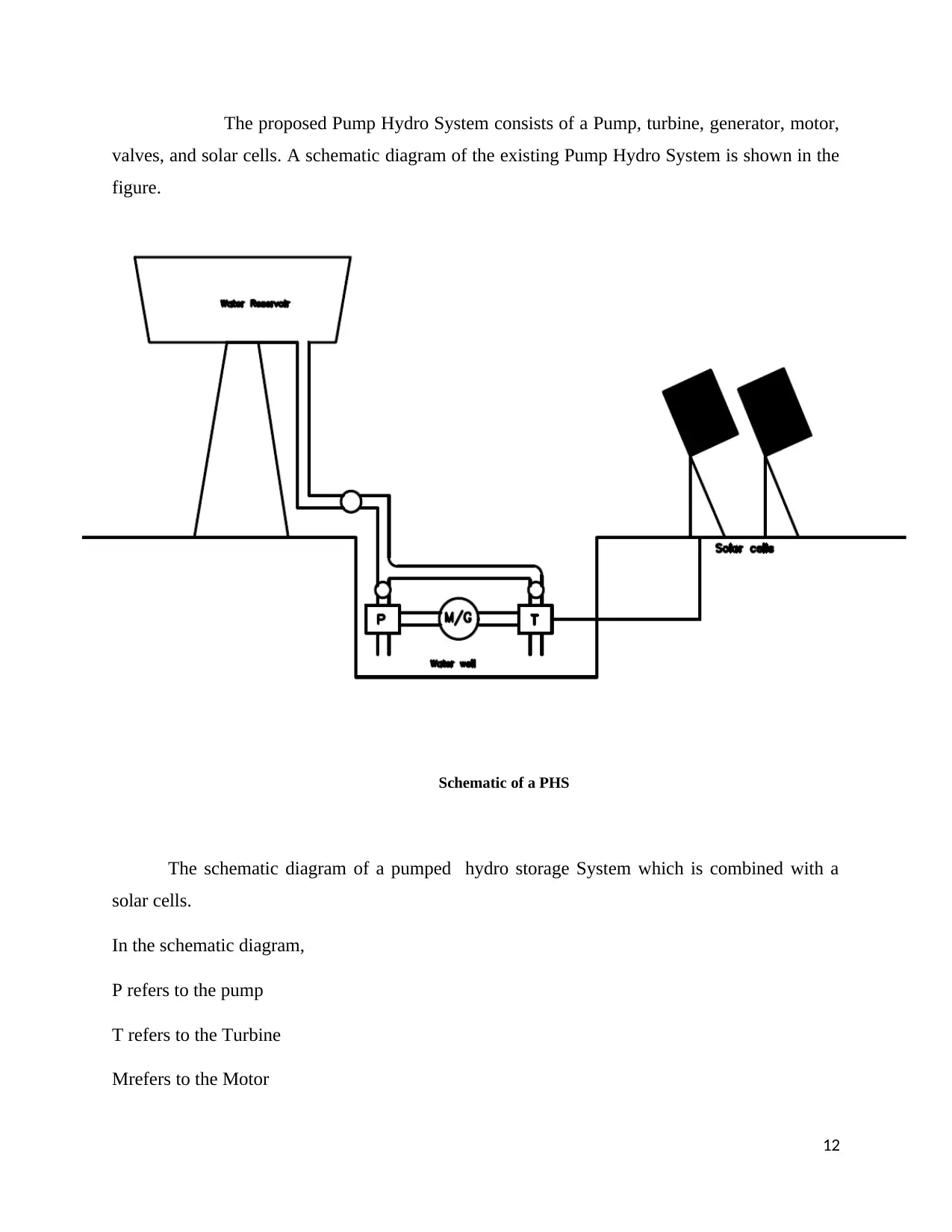
The proposed Pump Hydro System consists of a Pump, turbine, generator, motor,
valves, and solar cells. A schematic diagram of the existing Pump Hydro System is shown in the
figure.
Schematic of a PHS
The schematic diagram of a pumped hydro storage System which is combined with a
solar cells.
In the schematic diagram,
P refers to the pump
T refers to the Turbine
Mrefers to the Motor
12
valves, and solar cells. A schematic diagram of the existing Pump Hydro System is shown in the
figure.
Schematic of a PHS
The schematic diagram of a pumped hydro storage System which is combined with a
solar cells.
In the schematic diagram,
P refers to the pump
T refers to the Turbine
Mrefers to the Motor
12
⊘ This is a preview!⊘
Do you want full access?
Subscribe today to unlock all pages.

Trusted by 1+ million students worldwide
1 out of 32
Related Documents
Your All-in-One AI-Powered Toolkit for Academic Success.
+13062052269
info@desklib.com
Available 24*7 on WhatsApp / Email
![[object Object]](/_next/static/media/star-bottom.7253800d.svg)
Unlock your academic potential
Copyright © 2020–2025 A2Z Services. All Rights Reserved. Developed and managed by ZUCOL.




